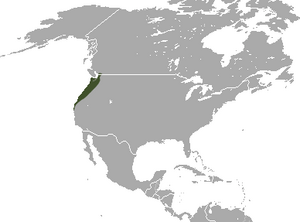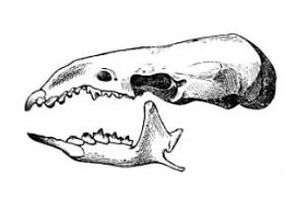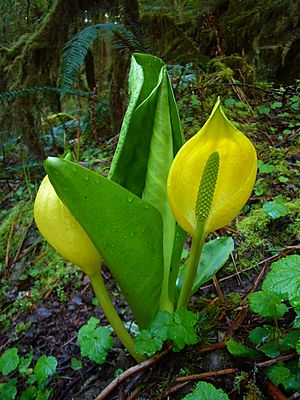Marsh shrew facts for kids
Quick facts for kids Marsh shrew |
|
|---|---|
 |
|
| Conservation status | |
| Scientific classification | |
| Genus: |
Sorex
|
| Species: |
bendirii
|
| Subspecies | |
|
|
 |
|
| Marsh shrew range | |
| Synonyms | |
|
List
Atophyrax bendirii
Merriam, 1884 Sorex bendirii Dobson, 1890 Sorex (Atophyrax) bendirii palmeri Merriam, 1895 |
|
The marsh shrew (Sorex bendirii) is also known by other names like the Pacific water shrew or Jesus shrew. It's the biggest shrew in North America that belongs to the Sorex group, which means "long-tailed shrews."
These shrews usually have dark-brown fur. You can find them near water in places along the Pacific coast, from southern British Columbia in Canada down to northern California in the United States. Marsh shrews are amazing because they can trap air in their fur. This helps them float and even run on top of the water for a few seconds!
A marsh shrew is about 16 cm (6.3 in) long, including its 7-centimetre (2.8 in)-long tail. It weighs around 14.5–16 g (0.51–0.56 oz). They mostly eat small creatures without backbones, like insects. They hunt for food both on land and in the water. Marsh shrews are not very common, and their numbers seem to be going down. Because of this, they are considered endangered in some areas where they live.
Contents
What Does the Marsh Shrew Look Like?
The marsh shrew is the largest shrew in North America from the Sorex family. Many people think it's a very nice-looking mammal. Its fur is mostly dark brown, and it has a long tail. Usually, its fur is dark all over its back and belly. However, some marsh shrews living on the Olympic Peninsula might have white fur on their bellies.
As mentioned, a marsh shrew is about 16 cm (6.3 in) long, with a tail that is about 7-centimetre (2.8 in) long. It weighs about 14.5–16 g (0.51–0.56 oz). Its back feet have a slight fringe of stiff hairs on the toes, and they measure about 19.2 mm (0.76 in).
Marsh shrews can sometimes live in the same areas as other Sorex shrews. But the marsh shrew is easy to spot because it's large, has velvety, gray-black fur, and no other shrew like it shares its home range. Only the American water shrew is similar in size. The American water shrew has darker fur on its back and a silver-grey belly. Its tail also has two colors. The marsh shrew's fringed hairs on its feet are more noticeable. The marsh shrew also has a longer nose than the American water shrew.
The marsh shrew's skull is quite big. It has a special curve that slopes downwards along its snout (nose area). The reddish color on its teeth is from iron. Scientists think this makes their teeth stronger.
How the Marsh Shrew Got Its Name
The marsh shrew was first described in science in 1884 by a scientist named Clinton Hart Merriam. He first called it Atophyrax bendirii. The very first marsh shrew specimen was found near Fort Klamath in Klamath County, Oregon.
Merriam got the shrew from Charles Bendire, who was an ornithologist (a bird scientist) and an army captain. A soldier found the shrew and gave it to Captain Bendire. Merriam named the shrew "Bendire's shrew" to thank Captain Bendire for his help. Merriam thought this animal was so unique that it belonged to a new group, which he called Atophyrax. This name comes from Greek words meaning "unusual shrew." Later, the marsh shrew was moved into the Sorex group, where most long-tailed shrews belong.
The marsh shrew and the American water shrew look very much alike. The marsh shrew lives in a smaller area, mostly along the northwest coast and the lower parts of inland mountains. The American water shrew lives in more places, across western mountains and in colder parts of Canada and the eastern U.S. These two species usually live in different areas, but sometimes their homes overlap in the Pacific Northwest. However, they tend to live at different elevations, which keeps them somewhat separate.
Marsh Shrew Subspecies
The marsh shrew has three different types, called subspecies:
- S. bendirii albiventer (Merriam, 1895)
- S. bendirii bendirii (Merriam, 1884)
- S. bendirii palmeri (Merriam, 1895)
S. b. albiventer lives on the Olympic Peninsula in Washington state. S. b. bendirii is found in the Cascades mountains and southwestern British Columbia. S. b. palmeri lives along the coast of Oregon. Scientists have identified these subspecies based on their fur markings, skull shapes, and tooth details.
Where Marsh Shrews Live
Marsh shrews live from southwestern British Columbia, Canada, down through the western parts of Washington and Oregon states, and into northwestern California. Their range goes as far south as the area north of San Francisco.
These shrews usually live in wet places like marshes. Their homes often have lots of trees and plants, as well as logs and other things on the ground for cover. They can also be found near rivers and streams. When it's cold and rainy, they might move up to a kilometer away from wet areas to find more sheltered spots. These spots are usually forests with fallen logs and other things to hide under.
Marsh shrews have been found from sea level up to about 4,356 ft (1,328 m) high in the Cascades mountains. They might live in forests with trees like red alder, bigleaf maple, western hemlock, or redcedar. They are often found near marshes where a plant called western skunk cabbage grows.
In British Columbia, marsh shrews are usually found below 600 metres (2,000 ft) in elevation. However, one was found at 850 metres (2,790 ft) in Mount Seymour Provincial Park. Officials in British Columbia think marsh shrews are one of the rarest small mammals in that area.
In 1983, scientists in western Oregon studied small mammals, including marsh shrews, near streams in forests. They found that marsh shrews made up less than two percent of all the mammals they caught. All the marsh shrews they found were right next to streams. They were found in all types of forests: very old forests, mature forests, and young forests.
Marsh Shrew Behavior and Life Cycle
The marsh shrew eats small creatures without backbones, like spiders, earthworms, and centipedes. It also eats insects and other tiny animals that live on land and in the water. One time, a marsh shrew in captivity was seen chasing and killing a goldfish, but it didn't eat it.
A study of marsh shrews in Oregon showed that at least a quarter of their diet comes from aquatic (water) sources. This includes insect larvae, slugs, snails, and other small water creatures. Other studies show they also eat water beetles, stonefly nymphs, and different kinds of spiders and worms.
The marsh shrew is a good swimmer. It makes short dives to look for food underwater. It uses its flexible snout, whiskers, and lips to find and catch prey in the water. After catching food, it goes back to land to eat. The air trapped in its fur helps it float. Marsh shrews can even run on top of the water for 3 to 5 seconds! This trapped air also makes their fur look shiny and silver underwater. On land, they move their front leg and the opposite back leg at the same time.
Marsh shrews are active all year round, mostly at night. They usually live for about 18 months. Male shrews probably don't become old enough to breed during their first summer. Since they don't live very long, they likely only breed for one season. The breeding season is from late January to late August, and most young are born in March. We don't know how many litters a female shrew has.
Marsh shrews have a strong smell, like other long-tailed shrews. This smell might be a way for them to communicate with each other. Like many shrews, they don't have very good eyesight. If a marsh shrew is put on the edge of a raised surface, it might just run off the edge and keep running when it lands below. If it lands in water, it dives under. This might be why they are easily caught in sunken cans – they can't see the edges of surfaces very well.
In captivity, marsh shrews make chirping sounds if they are moved or if they fight with other shrews in their cage. They make a high-pitched twittering sound if someone bothers them while they are eating or if they are fighting over food. It's not known if marsh shrews hide food in the wild. But in captivity, they have been seen putting nightcrawlers in a corner of their cage to eat later.
Owls, fish, and the Pacific giant salamander are likely predators of the marsh shrew.
Marsh Shrew Conservation
Before the late 1960s, not much was known about marsh shrew behavior. Most of the information came from notes about where they lived and how to trap them. Scientists mostly learned about them by looking at museum specimens.
The Committee on the Status of Endangered Wildlife in Canada (COSEWIC) lists marsh shrews as "Endangered" in Canada. Their habitat in British Columbia is shrinking because of human activities. Since this trend is unlikely to change, they are very rare in that part of Canada. COSEWIC first called the marsh shrew "Threatened" in 1994, then changed its status to "Endangered" in 2006.
However, the IUCN says marsh shrews are of "Least Concern" for conservation globally. Even though they are considered rare and their numbers are thought to be declining, their population decline isn't fast enough to put them in a more threatened category worldwide. Their wetland homes are disappearing mainly because of cities growing and land being used for farming. Still, protected areas are expected to be set up within the shrew's wide geographic range to help them.
Images for kids
See also
 In Spanish: Musaraña de pantano del Pacífico para niños
In Spanish: Musaraña de pantano del Pacífico para niños









